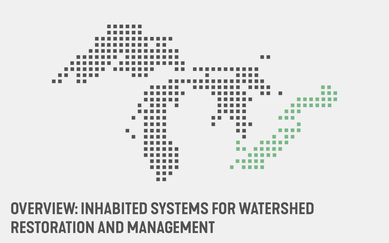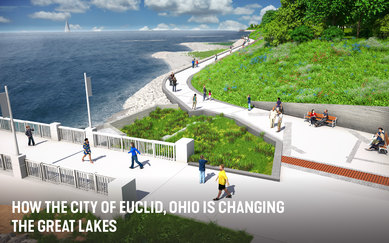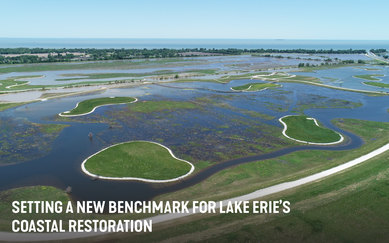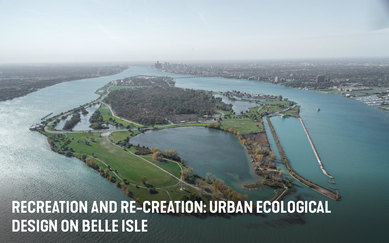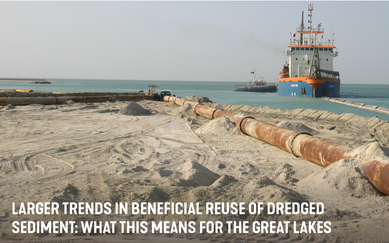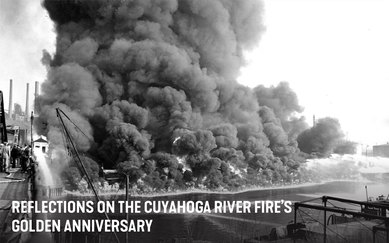大湖区的城市们:城市生态
Communities along Lake Erie and the Huron-Erie Corridor have long been grappling with ecological damage and loss. In this publication, SmithGroup explores the collaborative planning and design work helping to heal, restore, and protect Great Lakes ecology as an integrated part of the urban fabric. LEARN MORE
How the City of Euclid, Ohio is Changing the Great Lakes
By Jason Stangland
Urban planners and developers within the Great Lakes region are well aware of the limitations that private property ownership can place on public waterfront development and access. So how did SmithGroup and the City of Euclid, Ohio convince 100+ homeowners to allow public access along their lakefront properties? Jason Stangland shares how this precedent-setting project will stabilize Euclid's eroding shoreline while giving the public access to a prime swath of the city’s Lake Erie waterfront. LEARN MORE
Setting a New Benchmark for Lake Erie’s Coastal Restoration
By Emily McKinnon
Blending recreational use with ecological restoration, Toledo’s Howard Marsh Metropark has transformed over 750 acres of former farmland into diverse coastal wetland habitats. Emily McKinnon explains how this award-winning project is advancing a new kind of mixed-use restoration for Lake Erie and other environmentally challenged waterways. LEARN MORE
Recreation and Re-Creation: Urban Ecological Design on Belle Isle
By Andrew McDowell
Detroit’s Belle Isle State Park is one of the most widely known and frequently visited destinations in southeast Michigan. While it has been a popular gathering space for over a century, the island’s unique ecosystems have only recently gained attention. Andrew McDowell offers insight regarding the impactful ecological restoration projects that have been implemented across the island and how these projects provide added benefits to the community and the economy. LEARN MORE
Larger Trends in Beneficial Reuse of Dredged Sediment: What This Means for the Great Lakes
By Chris Devick
Dredged sediment is becoming an increasingly important resource for shoreline restoration and management efforts nationally. Chris Devick explores the new opportunities that Great Lakes communities have to reuse and repurpose what used to be considered a waste product. LEARN MORE
Reflections on the Cuyahoga River Fire’s Golden Anniversary
By Dan McGraw
2019 marks the 50th anniversary of the infamous Cuyahoga River fire in Cleveland. This piece reflects on how that fire became a catalyst for the creation of the EPA and the Clean Water Act. LEARN MORE
About SmithGroup’s Great Lakes Cities Initiative
The Great Lakes watershed represents one of the most significant urbanized regions in the world. With over 22 percent of the world’s fresh surface water supply, its shores, channels, and islands feature 10,000 miles of coastline—more than the contiguous United States' Pacific and Atlantic coastlines combined. The area is home to nearly 60 million people, with a GDP four times that of the Gulf Coast region.
The Great Lakes region is also home to six of SmithGroup’s offices. As awareness of the Great Lakes’ national and global importance grows, so too does our firm’s need to collaborate on impactful planning and design efforts committed to the future of the region’s communities.
Great Lakes cities have a widely shared history of development, industrialization and significant economic transformations. Their downtowns and waterfronts frequently have underutilized properties or decommissioned facilities in need of redevelopment and reuse. The region’s vital water and ecological resources are also threatened by pollution and urban runoff, as well as climate change.
From critical resilience issues impacting the region’s ecological balance, to shifting demand from industrial production and power generation, to the growing need for more sustainable economic and development models, Great Lakes cities are facing some of the most significant decisions in their history. Through our ongoing Great Lakes Cities Initiative, SmithGroup seeks to deepen our role as advocates and partners for our Great Lakes communities. Our goals are to develop and support innovative strategies and solutions, advance new research and ideas, and to share stories of significance and benefit for the future of the Great Lakes region.
